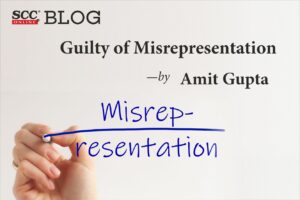The first courtroom scene in the recent Amazon prime series — “Guilty Minds” — shows a Supreme Court setting — a briefing counsel looks over her shoulder nervously to wait for the arguing counsel to turn up, a young supremely confident arguing counsel shows up and opposes vociferously, and the Judges pass an order even as he tries his level best to protest. The scene mirrors reality, as close as possible, of a usual Supreme Court miscellaneous day hearing. It was a refreshing change from the otherwise Hindi movie courtroom scenes I have seen growing up, such as, a villain gets hanged in courtroom (Shahenshah), or the hero opening an exhibit bottle and drinking it to prove that it is not poison (Meri Jung) or the most famous of all — tareek par tareek (Damini). The first courtroom scene, thus, got me interested as a lawyer.
At certain levels, the series reflects realities of the courtrooms and litigation practice; a courtroom facing power outage, Supreme Court precincts, immaculately trimmed lawyers of a big law firm, allegations against sitting Judge, parties trying everything possible to get a verdict, an experienced lawyer browbeating a witness, a young Harvard educated third generation lawyer being made a partner even as an associate having worked for year looks on in dismay among others and so on.
However, the reason for this write up is the depiction of the trials and preparation by the lawyers, which are far from reality.
In almost all the episodes, the lawyers are taken by surprise by the facts, which emerge once the court proceedings begin. In the process, once the so-called trial has started, the lawyers challenge themselves in gathering evidence and further information. Much talented and hardworking, as the lawyers shown in the series may be, all of them are scuttering around looking for answers after the trial begins. A client or a young lawyer can easily assume that it is normal to keep on looking for answers even after your case is before the court.
This, to my mind, is the biggest shortcoming of the series. To any layman or a fresh lawyer, such an approach is misleading and better ignored. A good litigator is supposed to gather and be aware of all the facts relating to the case. It is usual that the clients do not provide full information in the first instance whether intentionally or inadvertently. However, it is the job of a good lawyer to extract all the information that would be relevant for a case. Unlike what is shown in the series, a lawyer is not expected to go around looking for evidence once the case is before the court and the trial has already started. Even before filing a case or appearing in the court, a lawyer needs to be aware of the weak points of the case and a response to the same — either legal or factual – needs to worked out well in advance. I wish the series had reinforced the notion of prior hard work and assessment of factual and legal points before a case is filed. Unfortunately, it fails to do so.
The second issue is the mode and manner of trials. It seems funny that the witnesses are called out in random order, they are partly examined and then re-examined, and arguments are made even during the cross-examination. The series lawyers are not averse to calling the opposite side as their witnesses. As and when the lawyers discover new facts, the witnesses are recalled at pleasure. The procedure shown is alien to both civil and criminal law. In reality, the list of witnesses has to be provided in advance. The examination of the witnesses is not expected to be in phases, nor can they be recalled at will. I have never seen an opposing counsel calling the other side to appear as a witness. It is entirely the discretion of a party whether to stand in the witness box or not. If it does not, an adverse inference would be drawn. The cross-examination has to be precise and pinpointed. A smart lawyer would never put open-ended questions in the cross-examination to allow the other sides’ witness to blurt out whatever they may desire.
The writers of the series do show creativity in the kind of issues raised in each episode. However, the creativity ought not to have crossed over in depiction of the courtroom scenes. A series that starts on a promising note disappoints in not coming close to reality and ends up being misleading for the general public and young lawyers. Alas, we still have to wait for our very own “My Cousin Vinny” or “A Few Good Men”.

